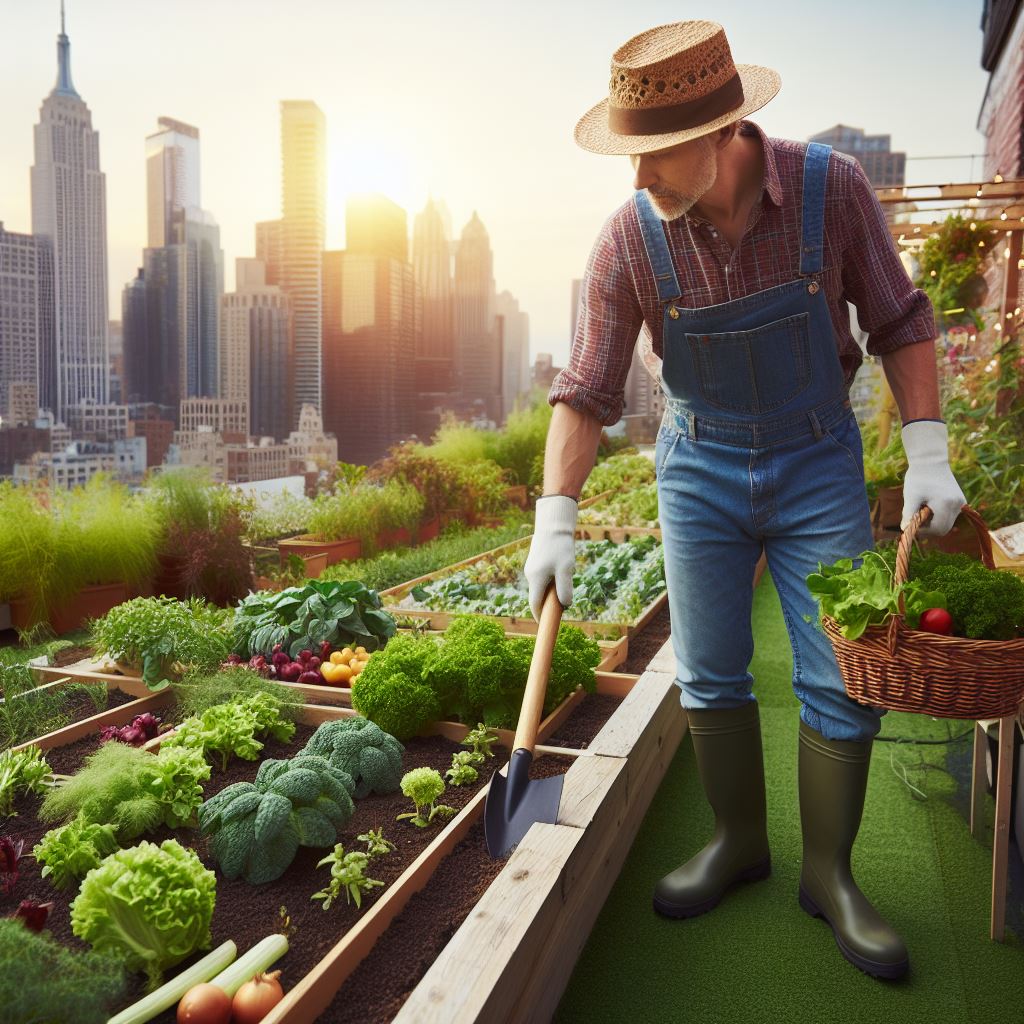Introduction
Roof gardens are becoming increasingly popular in urban areas.
These gardens are created on the rooftops of buildings, utilizing the available space to cultivate plants and create greenery in the midst of concrete jungles.
The importance of rooftop gardens cannot be understated.
Not only do they provide aesthetic value, but they also offer numerous environmental benefits.
They help to reduce the urban heat island effect, improve air quality, and mitigate stormwater runoff.
Rooftop gardens are gaining popularity as people become more aware of their potential benefits.
The greening of urban spaces has become a trend, with individuals, businesses, and even governments embracing the concept of rooftop gardens.
With the rapid urbanization of cities, there is a need to transform urban landscapes and make them more sustainable.
Rooftop gardens offer a solution to this challenge by providing an opportunity to utilize unused spaces and create green pockets in urban areas.
Basically, rooftop gardens offer numerous benefits and have the potential to transform urban landscapes.
They provide aesthetic value, contribute to environmental sustainability, and improve the overall well-being of urban dwellers.
Embracing rooftop gardens is a step towards creating greener and healthier cities.
Benefits of Rooftop Gardens
Environmental benefits
- Roof gardens help in reducing the urban heat island effect.
- They contribute to better air quality by absorbing carbon dioxide and releasing oxygen.
- Roof gardens provide a habitat for birds and insects, promoting biodiversity in urban areas.
Social benefits
- Rooftop gardens enhance community cohesion and well-being by providing a shared green space.
- They create urban oases and spaces for relaxation, offering a retreat from the hustle and bustle of the city.
- Rooftop gardens promote physical and mental health, as they provide opportunities for outdoor activities and stress reduction.
Economic benefits
- Rooftop gardens can help in reducing energy consumption by providing insulation and cooling effects on buildings.
- They also increase property value, as green rooftops are considered desirable features in real estate.
- Rooftop gardens have the potential to support urban agriculture and local food production, creating economic opportunities.
Read: City Herbs: Growing Flavor in Tiny Spaces
Designing and Implementing Rooftop Gardens
Designing and implementing rooftop gardens require careful considerations to ensure their success and longevity.
From structural aspects to plant selection, as well as maintenance and irrigation, every step plays a crucial role in creating a thriving green space above our heads.
Transform Your Agribusiness
Unlock your farm's potential with expert advice tailored to your needs. Get actionable steps that drive real results.
Get StartedStructural considerations
To begin with, it is essential to assess the load-bearing capacity of the roof before starting a rooftop garden project.
The weight of the garden, including plants, soil, containers, and other elements, must be within the load-bearing limits of the structure.
This evaluation will prevent any structural damage and ensure the safety of the building and its occupants.
Another critical consideration is the installation of waterproofing and drainage systems.
Since rooftops are exposed to the elements, they need to be properly waterproofed to prevent leaks and water damage to the building below.
Drainage systems must also be incorporated, allowing excess water to flow away from the rooftop garden and prevent waterlogging.
Choosing suitable plant varieties
Selecting the right plant varieties is crucial for a successful rooftop garden.
It is advisable to choose plants that can thrive in the unique conditions of a rooftop environment.
Drought-tolerant and wind-resistant plants are excellent choices as they can withstand the intense sun, heat, and wind that rooftops are often exposed to.
Additionally, consider the composition and depth of soil to provide optimum growing conditions for the plants.
Lightweight, well-draining soil mixes are commonly used to minimize the weight load on the structure while still providing the necessary nutrients for plant growth.
Maintenance and irrigation
Maintaining a rooftop garden involves specific considerations, especially when it comes to irrigation and water use.
Implementing efficient watering strategies like drip irrigation systems can help conserve water and ensure that plants receive the required moisture without wastage.
Additionally, incorporating rainwater harvesting systems can further reduce reliance on the municipal water supply.
Regular inspections are essential to identify any potential issues and perform necessary repairs promptly.
This includes checking for leaks, damaged plants or containers, and any signs of structural stress.
By addressing problems early on, further damage can be prevented, and the longevity of the rooftop garden can be extended.
Seasonal care practices are also vital in maintaining a healthy rooftop garden.
Pruning plants, removing weeds, and applying fertilizers appropriately are essential tasks.
Moreover, implementing effective pest management strategies is crucial to prevent infestations that could damage the plants.
Regular monitoring and timely action can keep pests under control and ensure the garden’s overall health.
In general, designing and implementing rooftop gardens require careful attention to various aspects.
From considering the load-bearing capacity and waterproofing to selecting suitable plant varieties and implementing efficient maintenance and irrigation practices, each step contributes to the success and sustainability of the rooftop garden.
By following these considerations, anyone can create a vibrant oasis in the sky and enjoy the benefits of greenery in an urban setting.
Showcase Your Farming Business
Publish your professional farming services profile on our blog for a one-time fee of $200 and reach a dedicated audience of farmers and agribusiness owners.
Publish Your ProfileRead: Watering Tips for Small Gardens & Farms
Inspiring Examples of Rooftop Gardens
In this section, we will explore inspiring examples of rooftop gardens in various settings, including residential buildings, commercial buildings, and public spaces.
These green havens not only provide aesthetic beauty but also offer a range of benefits to the people who enjoy them.
Rooftop gardens in residential buildings
Benefits for apartment dwellers
Living in an apartment can sometimes limit access to nature, but rooftop gardens are changing that.
These green spaces help apartment dwellers reconnect with nature and provide numerous benefits.
Residents can unwind and relax in an oasis amid the bustling city.
With rooftop gardens, apartment dwellers can enjoy the following advantages: improved air quality, reduced noise pollution, increased biodiversity, and enhanced mental well-being.
These gardens give residents a sense of serenity and offer a peaceful retreat from their busy lives.
Innovative solutions for limited space
Urban areas often face space constraints, making it challenging to create gardens or green spaces.
However, rooftop gardens provide an innovative solution to maximize limited space.
By utilizing rooftops, unused areas are transformed into beautiful gardens.
These gardens allow residents to interact with nature without needing traditional ground-level spaces.
They offer opportunities for urban farming, growing vegetables, and cultivating flowers.
Rooftop gardens also contribute to the energy efficiency of buildings by providing natural insulation.
Rooftop gardens in commercial buildings
Incorporating green spaces into office environments
Office environments are increasingly incorporating rooftop gardens to create a healthier and more enjoyable workspace.
These green spaces provide employees with a break from their desks and offer a connection to nature, promoting overall well-being.
Rooftop gardens contribute to improved air quality, reduced stress levels, and increased productivity among employees.
They also serve as a place for relaxation and social interaction, fostering a sense of community within the workplace.
Enhancing customer experience in restaurants and hotels
Restaurants and hotels are using rooftop gardens to elevate the customer experience.
These green spaces create an inviting ambiance, allowing patrons to dine or relax in a natural setting with stunning views.
Rooftop gardens in restaurants may also provide fresh ingredients for their dishes, showcasing sustainable practices and enhancing the culinary experience.
In hotels, these gardens offer guests a serene retreat, making their stay more memorable and enjoyable.
Rooftop gardens in public spaces
Parks, schools, and community centers
Public spaces such as parks, schools, and community centers are recognizing the potential of unused rooftops.
By transforming these spaces into thriving gardens, they provide additional recreational and educational areas for the community.
Rooftop gardens in public spaces contribute to environmental sustainability by increasing green spaces in urban areas.
They offer opportunities for children to learn about gardening, ecology, and sustainable practices.
These gardens also serve as gathering places for community events and activities.
Transforming unused rooftops into vibrant gardens
Empty rooftops have untapped potential to become vibrant gardens.
By implementing rooftop gardens, cities can address the challenge of unused space and transform them into havens of greenery.
These gardens add a touch of nature to the urban landscape, making the city more livable and environmentally friendly.
Rooftop gardens also help mitigate heat island effects, reduce stormwater runoff, and enhance energy efficiency.
They contribute to the overall well-being of the community by providing recreational areas, promoting biodiversity, and improving air quality.
In a nutshell, rooftop gardens have become inspiring examples of incorporating greenery into various settings.
Whether in residential buildings, commercial spaces, or public areas, these gardens offer numerous benefits and bring nature closer to people’s lives.
With their beauty and functionality, rooftop gardens are changing the way we interact with our urban environments.
Read: Seasonal Planting Strategies for Hobbyists

Challenges and Future Outlook
Limited awareness and education
One of the major challenges in the widespread adoption of rooftop gardens is the limited awareness and education about their benefits.
Many people are not familiar with the positive impact that rooftop gardens can have on the environment, as well as the numerous benefits they offer to individuals and communities.
To address this challenge, it is crucial to spread knowledge about the benefits of rooftop gardens.
This can be done through various means, including educational campaigns, workshops, and online resources.
Showcase Your Farming Business
Publish your professional farming services profile on our blog for a one-time fee of $200 and reach a dedicated audience of farmers and agribusiness owners.
Publish Your ProfileBy increasing awareness, more individuals and communities can become interested in implementing rooftop gardens and experiencing their positive effects.
Additionally, providing resources for designing and implementing rooftop gardens is essential.
This includes guidance on choosing suitable plants, designing efficient irrigation systems, and understanding the structural requirements of rooftop gardens.
By offering these resources, individuals and organizations can overcome the initial barriers and challenges associated with rooftop garden implementation.
Regulatory and legal hurdles
Another significant challenge in the development of rooftop gardens is navigating the regulatory and legal landscape.
Building codes and permits often pose obstacles to implementing rooftop gardens, as there may be specific requirements and restrictions related to structural modifications and irrigation systems.
To overcome these hurdles, it is essential to work closely with local authorities and building departments to ensure compliance with regulations while advocating for rooftop garden-friendly policies.
Encouraging policy changes at the municipal or national level can help streamline the process of obtaining permits and promote the integration of rooftop gardens into urban planning strategies.
Advancements in rooftop garden technology
The future of rooftop gardens lies in advancements in technology that can enhance their functionality and sustainability.
One area of focus is the development of sustainable irrigation systems that minimize water consumption and reduce the reliance on traditional water sources.
Incorporating technologies such as rainwater harvesting, drip irrigation, and moisture sensors can help optimize water usage in rooftop gardens, making them more environmentally friendly and efficient.
This not only reduces water waste but also lowers maintenance costs.
Furthermore, implementing smart solutions for maintenance and monitoring can greatly improve the longevity and effectiveness of rooftop gardens.
By utilizing remote monitoring systems, sensors, and automation, it becomes easier to detect and address issues such as plant health, pest infestations, and irrigation malfunctions.
in essence, the future outlook for rooftop gardens is promising, but not without its challenges.
By addressing limited awareness and education, navigating regulatory hurdles, and embracing advancements in technology, rooftop gardens can become an integral part of sustainable urban environments.
Read: Composting: A Guide for Urban Farmers
Discover More: Rooftop Herb Havens: Cultivating Flavor
Conclusion
Recap of the benefits and potential of rooftop gardens.
Rooftop gardens offer numerous benefits and have tremendous potential in urban environments.
They provide a solution to urban space constraints while promoting sustainable living.
By converting rooftops into green spaces, we create habitats for birds and insects, enhancing biodiversity.
This helps to counteract the negative effects of urbanization on ecosystems.
Additionally, rooftop gardens mitigate the heat island effect, reducing energy consumption and lowering temperatures in cities.
They act as natural insulation, resulting in energy savings for buildings and improving their overall efficiency.
These green spaces also improve air quality by filtering pollutants and absorbing carbon dioxide. They contribute to a healthier and more pleasant environment for residents, reducing the risk of respiratory diseases.
Encouragement to explore rooftop garden possibilities
We should encourage individuals and businesses to explore the possibilities of rooftop gardens.
The potential for sustainable food production, recreational spaces, and social gatherings is immense.
Imagine a rooftop filled with vibrant flowers, fruits, and vegetables, providing fresh produce for urban communities.
Rooftop gardens can also serve as tranquil retreats, offering an escape from the hustle and bustle of city life.
Moreover, these gardens can be used as educational spaces, teaching children and adults about the importance of nature, environmental sustainability, and food production.
Call to action for supporting and promoting green initiatives within urban environments
To fully realize the potential of rooftop gardens, we need support and promotion from governments, businesses, and individuals.
We must strive to integrate green initiatives into urban planning and design.
Let us advocate for policies that incentivize the development of rooftop gardens and offer financial assistance to those who want to establish them.
Furthermore, we should educate others about the benefits of rooftop gardens and inspire them to take part in this green revolution.
By working together, we can create a greener and more sustainable future for our cities.
Rooftop gardens are just one step towards a healthier and more harmonious urban environment.
Let us join hands in promoting and supporting these transformative green initiatives.




